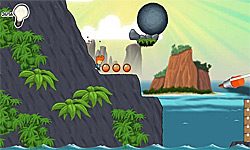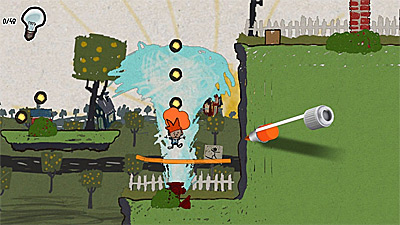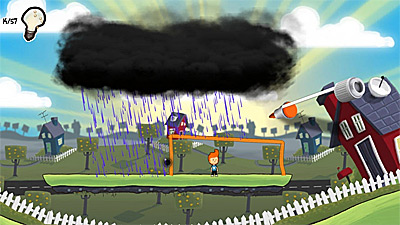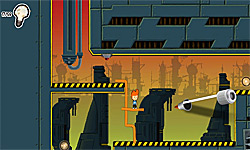Freedom in games is often an important element for many gamers, and it’s something that’s spearheaded entire franchises. However, whereas some games strive to offer players the ability to tackle the experience in whatever order they choose or with a specific moral intent, Max & the Magic Marker asks players to fill in the actual blanks when it comes to level design. It’s a refreshing, well-executed example of what the Wii is all about.

Max & the Magic Marker offers only a sliver of story, but it’s all the excuse you’ll need to run through the game’s 15 levels (scattered across three worlds). Max is a young boy with a vivid imagination, and through his magic-marker doodling, he gives life to a fearsome monster. It’s your job to corral the monster back into the world of daydreams, and you’ll need to use Max’s knack for drawing in order to chase the enemy down.
For all intents and purposes, Max & the Magic Marker is a puzzle platfomer. You move Max with the analog stick on the Nunchuk, jump with the Z button, and you can move objects by holding down C. In addition to controlling Max, however, you’ll also need to draw things into the world with your trusty magic marker, controlled with the Wii Remote. Though the platforming takes a little getting used to, the controls, overall, feel tight and well thought out.
There are three main worlds in the game, with the first five levels basically serving as the tutorial. The level of challenge quickly ramps up, however, and players will immediately be asked to think outside the box in order to progress through levels.
The thrust of the entire game, of course, is in presenting the player with obstacles that can only be overcome by drawing things into the world to aid you. Come upon a chasm? Draw a simple bridge and cross over. Enemies patrolling? Create a boulder to fall on their heads and defeat them.

The game registers density and gravity too, so if you simply draw a circle from a short height and attempt to drop it on an enemy, they’ll be unaffected; fill that circle in, however, and then drop it from a greater distance, and it’s sure to take the enemy out. The magic marker is an impressive tool, one created to give the player freedom to tinker ’til their heart’s content.
Physics also play an important role in the game, and though there’s the occasional frustrating moment when things you’ve drawn turn or bounce around unpredictably, it’s an element of the experience that once again opens things up in refreshing ways. At one point you might come upon what seems to be a dead end, though drawing a line across a stone to create a sort of seesaw and then drawing a heavy weight and letting it fall on the other end will allow you to propel yourself upward, revealing the way forward.

Additionally, Max can pause time by pressing both the A and B buttons simultaneously, and it’s a technique that’s incorporated wonderfully into the gameplay. For example, you’ll occasionally come upon parts of a level where there are conveyers with no belts or platforms to jump onto. If you attempt to draw a platform first and then have Max jump onto it, the platform will be propelled forward before Max has a chance to get on. You’ll first have to jump toward the conveyer, freeze time, draw the platform, and then unfreeze time, so that Max will land on the platform at just the right time in the sequence. The latter levels, especially, will call for some pretty crazy amounts of ingenuity on the player’s part.
Throughout the game, you’ll be required to collect small orbs containing ink for your magic marker. Each time you pass a checkpoint, your nemesis will empty your marker, which constantly forces you to create what you need with a very limited supply of ink. You will eventually unlock a feature that allows you to play through levels with a marker that never runs dry, but your progress won’t be saved when making use of this little extra. Using the full marker is a great way to take a peek at levels you might be having trouble with, but you’ll still want to go back and replay those levels as they were intended – the reason being: the achievements acquired give you access to some pretty sweet unlockables.

Though the actual platforming in Max & the Magic Marker isn’t on par with the likes of Mario, the mechanics and collision detection are still spot-on. Max runs and jumps with a feel similar to that of LittleBigPlanet, though having to contend with only one plane of the Z-axis makes the experience feel much more satisfying.
What sets the core mechanic of Max & the Magic Marker apart from games such as Drawn to Life is its use of space. In Drawn to Life, for instance, the player is merely filling in a preset portion of the landscape already set aside by the developers; regardless of what you draw, the interactivity with objects is always the same. With Max, however, everything you create has its own unique collision detection and physics, meaning that no two players will experience the game in exactly the same way.
Visually, Max & the Magic Marker is simple yet appealing. The levels of the first world are quite beautiful, in fact, though the graphics seem to become less interesting as the game progresses; the second world doesn’t look quite as good as the first, and the third world doesn’t look as good as the second. Overall, though, it’s an attractive package, one that seems to borrow from the shabby-chic stylings of World of Goo.
The sound effects and music are slightly less impressive, but they still manage to serve their function well. You’re essentially hearing three different themes – one for each world – and though it’s interesting how the music will sometimes stop in a holding pattern of sorts as you work out a specific portion of a level, the repetition can drive you a bit batty at times. The sound effects are pleasant and match the motif nicely, but the game, overall, could use a little extra “umph!”
Max & the Magic Marker probably could have been done on either of the other two consoles with decent results, much like Okami originated on PS2. However, the natural feeling you get when using the Wii Remote to control Max’s magic marker is delightfully intuitive, and the entire experience exemplifies what WiiWare games should attempt to live up to. The game’s a bit short, but you’ll still get a good few hours of fun out of the adventure. The unlockables offer ample incentive to replay levels, hitting target times and collecting orbs. There’s even a playground where you can fool around with the marker mechanics – the ideal test bed for various ideas that can be used in actual levels. If you were enamored by the creative ideas promised by games such as Drawn to Life, definitely give Max & the Magic Marker a look. It’s not an epic adventure by any means, but there’s still something magical about it.
RATING OUT OF 5 RATING DESCRIPTION 4.0 Graphics
The first world really shows off some great style, though the game becomes increasingly less interesting to look at as the adventure wears on. The overall presentation, however, is first-rate for WiiWare. 4.4 Control
As a left-handed player, it took me some time to get used to the platforming. Everything is mapped smartly, however, and the gameplay is all very well crafted. 3.9 Music / Sound FX / Voice Acting
Themes match the gameplay well, as do the sound effects. A lack of impact and variety in the audio department make the presentation feel a bit hollow. 4.0
Play Value
For 1000 Wii Points, Press Play presents players with a fairly full package here, complete with meaningful unlockables.
4.0 Overall Rating – Great
Not an average. See Rating legend above for a final score breakdown.
Game Features:
